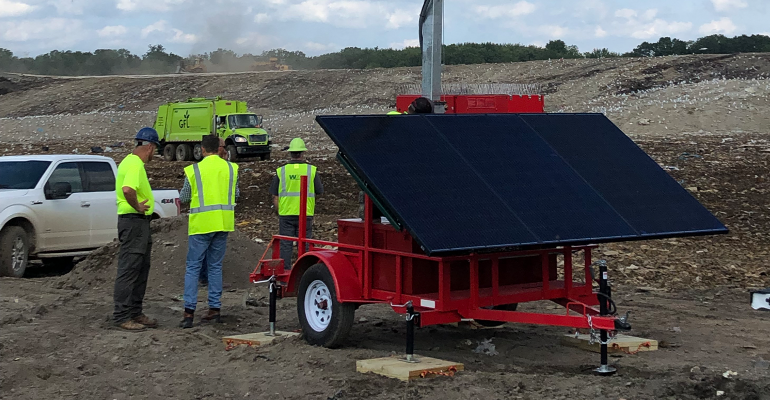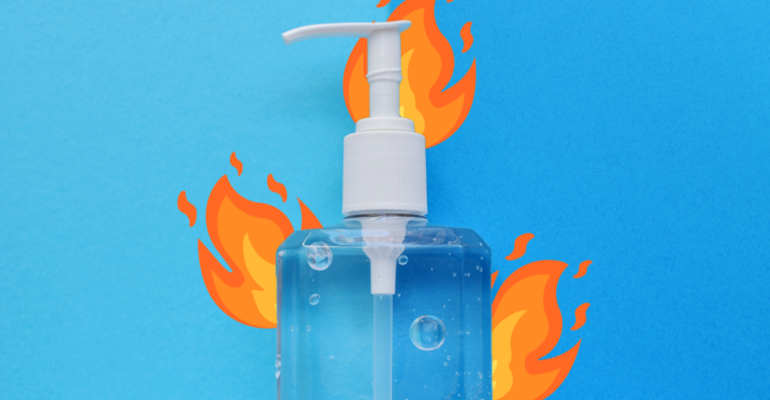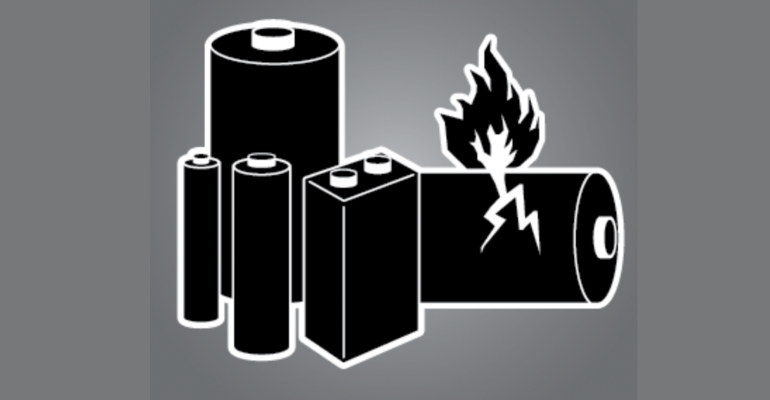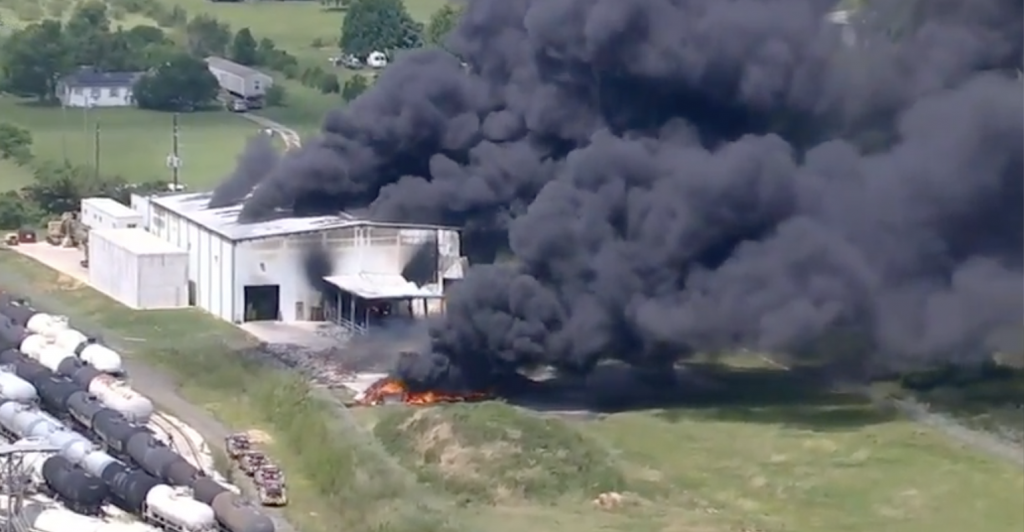
Conversations around lithium-ion batteries (LIBs) and fires in the waste and recycling industry are ramping up as more data becomes available and more reports are published. But what will it take for us to truly combat this issue? Read on to learn more.
August 2021 Fire Data
In August, we encountered 29 reported fire incidents at our waste and recycling facilities in the U.S. and Canada. Of these reported incidents, 15 occurred at waste, paper and plastic operations, 10 occurred at scrap metal operations, three occurred at construction and demolition operations and one occurred at a rubber recycling operation. At Fire Rover’s 250-plus client operations, we responded to 92 fire incidents in August to go along with the 74 from April, 88 from May, 77 in June and 88 in July.
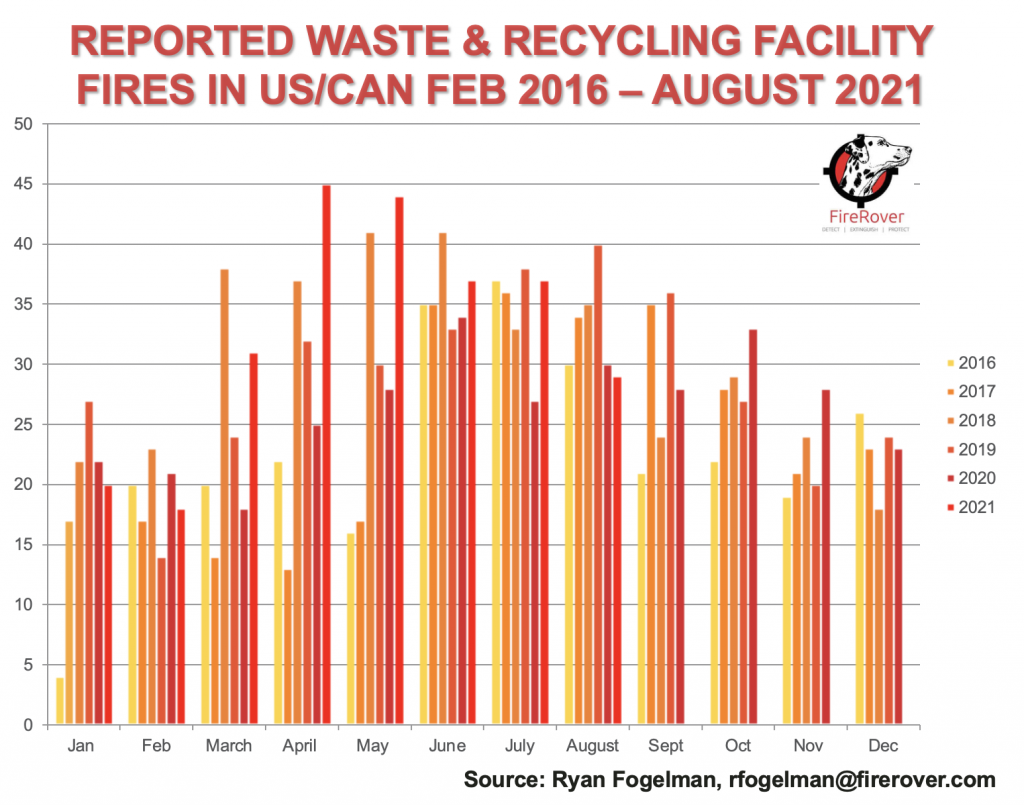
MRFs and Fire Professionals Are Victims
Since I began reporting waste and recycling facility fires, I have been steadfast in my observation that materials recovery facilities (MRFs) and our local fire professionals are the victims of the public’s insatiable thirst for lithium-ion battery power and convenience. There have been a number of studies that have backed up this assertion, including a report from Eunomia Research & Consulting for the UK market and a newly released report by the U.S. Environmental Protection Agency (EPA). Both reports make it very clear that direct and indirect costs borne by the global waste and recycling industry (and in turn the insurance companies) are completely lopsided to the detriment of the operators and our nation’s fire professionals.
The EPA’s report includes information from various sources, including my research and methodology from the “4th Annual Reported Waste & Recycling Facility Fires US/CAN” report, stating “the report includes fires from sources other than LIBs but shows an alarming year-over-year increase in waste fires. … The report’s author [Ryan Fogelman] believes that fires are underreported, and that there were actually more than 1,800 facility fires in 2019, or five times the reported figure.”
The EPA was referring to my historical data from 2016-2020, but little did we know what this year would have in store for us. Through the first eight months of this year, my data is predicting nearly 400 reported fire incidents for 2021, a 20 percent increase in incidents from 2020 and an 8 percent increase over 2018, the next closest year on record. Additionally, my assumption of actual fire incidents is based on a six-times multiple based on a population assumption of the UK versus the U.S. and Canada, so currently, I believe that the real number stands at 2,400 for 2021, or 400 forecasted fire incidents times six.
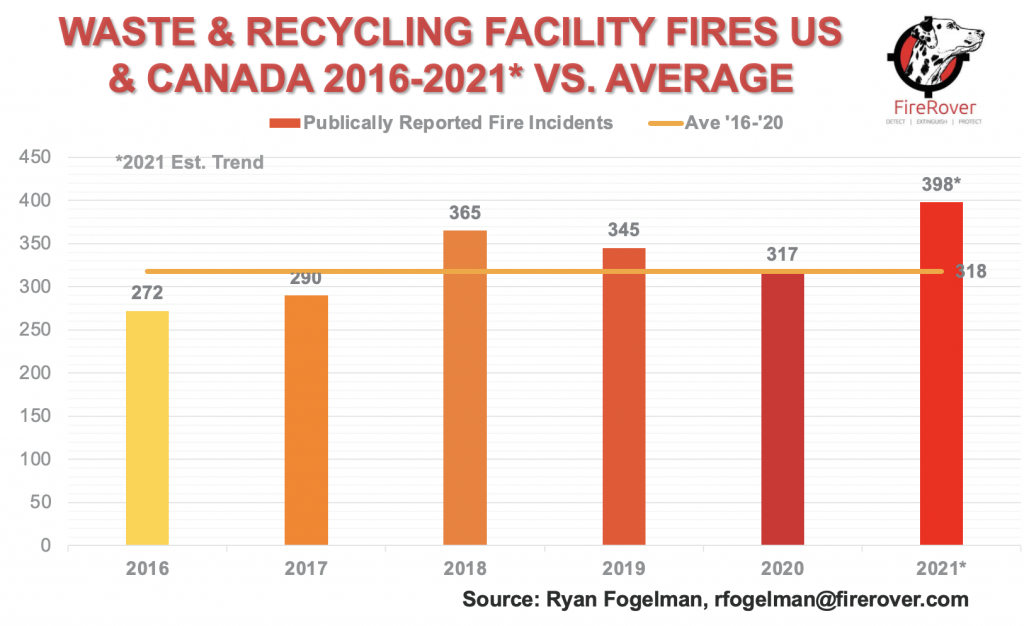
I still believe that 2,400 fire incidents is a conservative number and underreported. Think about it for a second. If we at Fire Rover are putting out more than 1,000 fire incidents annually at 250-plus sites, how many are happening daily in facilities we are not protecting? For example, in its report, the EPA highlights a few Rumpke articles from 2016 and 2017 where Rumpke reported to the press six and 12 fire incidents due to lithium-ion batteries reported at a single MRF. If we have about 1,000 MRFs in operation in the U.S., that is 6,000 to 12,000 annual incidents.
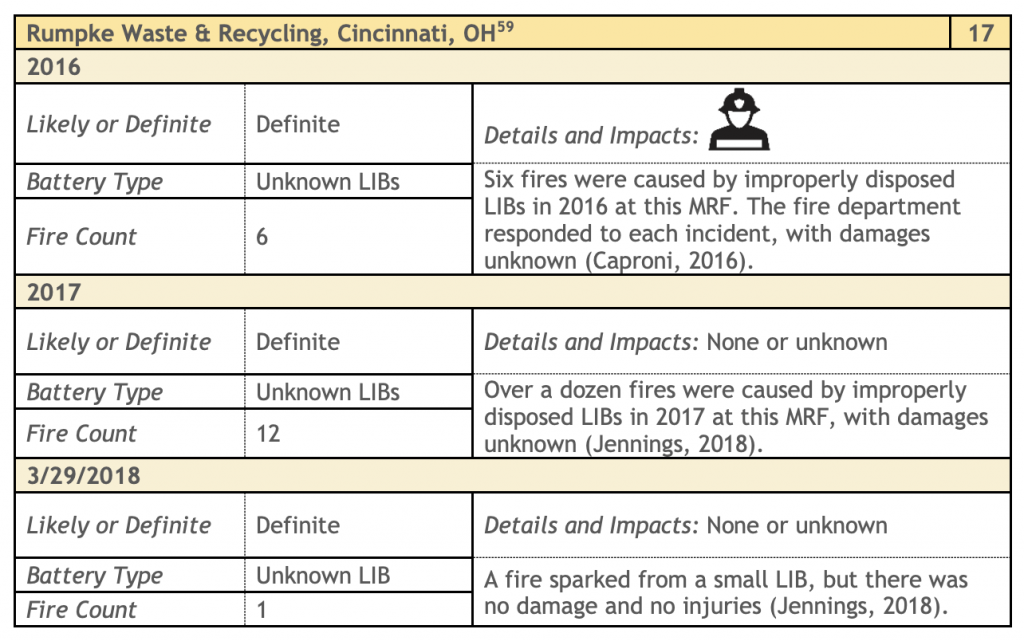
To better understand how this issue is projected to play out in the future, I believe it’s important for all of us in the industry to read the EPA report’s concluding paragraphs below:
This problem [referring to damage caused by LIBs] is only going to get worse in future years. LIBs are already present in a wide array of applications, and their prevalence is increasing. As devices containing these batteries reach the ends of their useful lives, they will contribute to the surging number of waste LIBs produced. … Solid waste regulations, industry best management practices, and facility-level strategies have thus far fallen short of addressing these problems. Fires in these locations pose a direct threat to reliable waste management services, environmental quality, and human health. LIB fires can also introduce financial pressures, raise costs to households, and lead to furloughs or layoffs. Other reports and surveys have hinted at these impacts, but this report specifically compiled significant evidence that LIBs are creating major problems for institutions across the waste management industry. The quantitative data collected here indicate that LIB fires at waste facilities are increasingly frequent, widespread, and harmful. Injuries, demand for emergency responders, service disruptions, and monetary impacts have all resulted from LIB fires. Across the board, a significant proportion of facilities have experienced at least one of these negative impacts in recent years. MRFs, in particular, appear to frequently suffer from LIB fires, threatening the continued availability of the environmentally beneficial waste management services they offer. Likewise, discussions with representatives from across the waste management industry reveal that this issue is well known and pressing. Each representative consulted agreed that LIB fires pose a threat to their operations that needs to be addressed—most even declared this issue to be the most pressing problem currently facing their industry.
As this report’s research methodology and discussions with industry representatives reveal, the problem of LIBs entering the waste system and the impacts they cause are severely underestimated. Relying solely on media reports of fire incidents at waste facilities will lead to underreporting of both the frequency and severity of this problem. News coverage of these fires is rare and heavily dependent on numerous external factors. When media sources do cover such events, they rarely address the full range of detrimental impacts they cause, focusing far more on the immediate response and very little on the indirect damage done to the waste system, human health, the environment, or even proper battery management.
In spite of this obstacle, this report presents ample evidence showing that LIBs in the waste management process are a major issue and it is likely that the problem is even bigger than we know. Waste facilities’ pragmatic responses, heightened awareness of workers in the field, rising insurance rates, anecdotal reports, and quantitative evidence all demonstrate that the issue of improperly discarded LIBs is a serious and growing concern for members of the waste management industry. While this report contributes to increasing general awareness of the threat posed by improperly discarded LIBs, solving this problem will require further coordination and action by the wide variety of stakeholders who share an interest in maintaining a safe, effective, and sustainable waste management system.
In order for us to combat the problem with LIBs and fires in our waste and recycling stream, we must take the last line bolded above seriously and understand the following facts:
- There is an inherent risk of fire incidents in the waste and recycling industry.
- Most of the costs of these incidents unfairly falls on our waste and recycling operators and the local fire professionals.
- There is not a consensus solution to the problem, but there are effective solutions to the problem.
Solutions to Our Growing Fire Problem
While there are solutions to the LIB fire problem in our industry, education has been the only solution that the entire industry has agreed upon. Most jurisdictions, associations, private money and government funding have gone to this end. I am definitely a proponent of teaching the public about recycling correctly and the dangers that come when items are placed in the wrong bin, but the reality is that it is confusing, expensive and largely ineffective in the short term. We have been spending these dollars for a few years and are still having major incidents and catastrophic losses like the EPA report highlights.
Additionally, education only influences curbside recycling and waste operations. It has no effect on the fires at scrap metal, construction and demolition and e-scrap operations, which still deal with LIBs as part of a power source in appliances, cars, burned down buildings and more. Using the number Eunomia came up with in the UK, I estimate the cost of these fire incidents across the U.S. is around $1.2 billion dollars annually. Double that number if you add in all the rest of the non-LIB hazards causing fires in our waste and recycling streams.
So, we are left to focus on prevention (good operators have less fires), engaging employees in fire brigade emergency activities and our patented Fire Rover solution. Our solution currently protects more than 250 waste and recycling facilities in the U.S. and Canada, and soon facilities in the UK and Australia. Not only is our patented solution eliminating fires of all types at waste and recycling operations, but it’s also keeping employees and firefighters safe, protecting facilities and saving our clients from the costs of catastrophic fires at their facilities.
It is true that some folks don’t like the idea that our solution has a cost to install and maintain. The free market has been set up to drive innovative solutions to problems like the one we are facing that the EPA clearly states: “Each representative consulted agreed that LIB fires pose a threat to their operations that needs to be addressed—most even declared this issue to be the most pressing problem currently facing their industry.” The fact is having our solution properly installed onsite mitigates a site’s risk to a manageable level where the insurance industry is comfortable.
The EPA hangs its hat on the fact that understanding LIB fires requires specific evidence to be correct, but the truth is most of the surveys I have read are clear that LIBs cause about half of the fires at these facilities and all these fire risks, whether LIB or not, need to be protected with the same solution. They also need to be caught and dealt with in the safest and most cost-effective way, which no one can argue is as early in the fire development stages as possible.
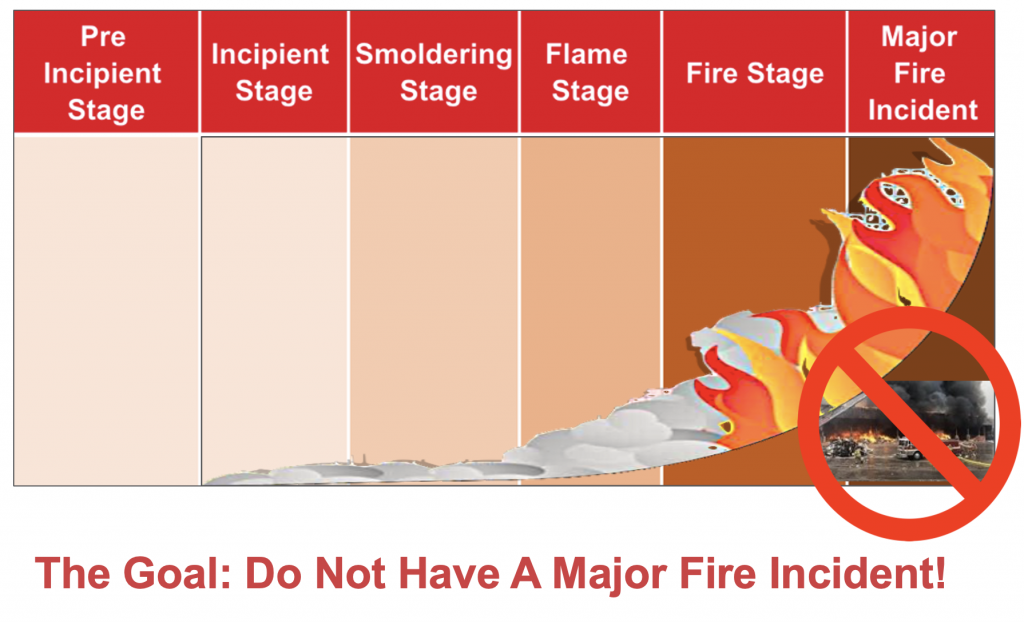
Take a look at this video that shows an incident that occurred at one of our client’s facilities. The truth is we do not know if this was caused by a LIB, some woodchips or another accelerant that crosses the path of our waste and recycling operators’ facilities.
The point is that no matter what caused the fire, our solution would have performed the same way. Our solution protects a number of high-hazard operations including hazardous material processing operations, lithium-ion battery processing operations, refinery operations, industrial operations and the waste and recycling operations we know so well.
The fact is that LIBs and other fire hazards are not going anywhere anytime soon. I have been relaying this message for some time now, and the EPA recently agreed by stating the following in its report: “The quantitative data collected here indicate that LIB fires at waste facilities are increasingly frequent, widespread, and harmful. Injuries, demand for emergency responders, service disruptions, and monetary impacts have all resulted from LIB fires.”
Additionally, a report from MarketsAndMarkets revealed that the global lithium-ion battery market size is projected to grow from $41.1 billion in 2021 to $116.6 billion by 2030; it is expected to grow at a compound annual growth rate of 12.3 percent from 2021 to 2030.
Based on these surveys and reports, along with many others, I believe we have enough data, whether anecdotal or empirical, to prove there’s a major fire problem facing our industry. While our industry’s fire problem started well before LIBs infiltrated our waste and recycling streams, the problem will continue to grow unless we take definitive action.
Conclusion
The real question is who is going to foot the bill for the solutions? Currently, the costs of these fires fall squarely on the operators and fire professionals who protect these facilities. The industry needs help from the government and associations, but the industry deserves help from the battery manufacturers. We need to hold the entire lithium-ion battery supply chain accountable for the products it is manufacturing—not because the battery producers are evil corporations but simply because they should be good stewards in sharing the benefits and costs of the products they make.
Just like other industries facing similar problems, we only need the government to get involved if it believes the manufacturers should be held accountable for the products they are producing. For example, we would all expect the EPA to step in when a corporation pollutes a waterway and doesn’t clean up its own mess, so shouldn’t the process be the same for those producing products that are sparking fires and causing dangers to our facilities and employees? I don’t think there is one person out there who can honestly say it’s not in the public’s best interest to have safe and effective waste and recycling infrastructure in our country.
Awareness around this issue has increased, and it is now time for the stakeholders to come together and solve this problem.
